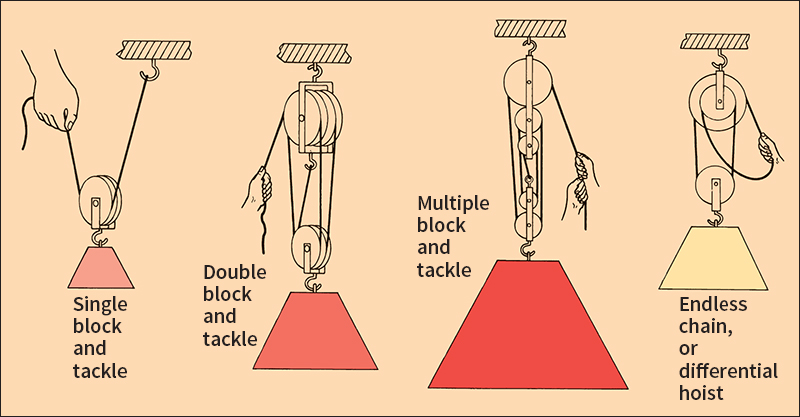Block and tackle is a machine used to lift weights and to exert large forces. It is made of pulleys and ropes, cables, or chains. The pulleys are mounted in frames called blocks. Each block has a hook by which it can be fastened to its support or to the load. A single block has one pulley, a double block has two pulleys, and so on.

Mechanical advantage.
The ideal mechanical advantage of a block and tackle equals the number of sections of rope that support the movable block. A single block and tackle has an ideal mechanical advantage of 2. Therefore, if friction did not act, a 1-pound pulling force could lift a 2-pound weight. However, since friction always acts, the weight that could be lifted with a 1-pound pulling force would be less than 2 pounds. Therefore, the actual mechanical advantage would be less than 2.
Adding sections of rope decreases the distance the load moves, to the same extent that it increases the ideal mechanical advantage. A 10-pound effort will lift 20 pounds with a single block. But the 10-pound effort must be moved 12 inches to make the 20 pounds move 6 inches. With a double block, a 10-pound effort will lift 40 pounds. But the rope must be pulled 12 inches to make the 40 pounds move 3 inches.
An endless chain hoist,
also called a differential hoist, has one pulley below to which the load is fastened. The upper block has two pulleys of different sizes. These pulleys are joined so that they turn together.
To raise the load, the upper pulleys are turned by pulling on the chain leading from the larger pulley. As it turns, the larger pulley raises one of the chains that support the load. At the same time, the smaller pulley lowers the other chain. Because the pulleys differ in size, the larger one raises one chain more than the smaller pulley lowers the other chain. As a result of this difference, the load is raised. The ideal mechanical advantage of the differential hoist equals the diameter of the larger pulley divided by the difference between the diameters of the two pulleys.
